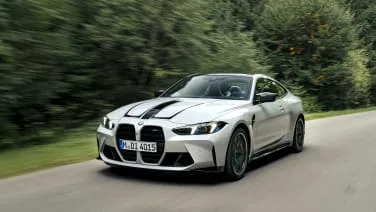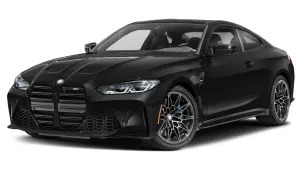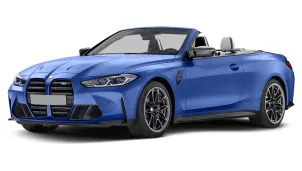Competition xDrive 2dr All-Wheel Drive Coupe
2022 BMW M4

Industry
THERMAL, Calif. — The BMW M3 and M4 have never been available with all-wheel drive — that is, until now. If it weren’t for the collective automotive world blowing a gasket over a grille design during the M3’s and M4’s initial reveal, the majority of the panic surely would’ve been directed toward the addition of an extra two driven wheels. It caused a kerfuffle when the M5 moved to all-wheel drive, but the execution was so blasted effective that complaints dried up quickly. Of course, one reason to not be upset about the existence of M3 and M4 xDrive models is that rear-drive M3s and M4s are not going anywhere. Another perk BMW tossed into the pot is the ability to completely lock power to only the rear wheels, just like it does with the M5. You’re forced to do without stability control in this two-wheel drive mode, but it’s better to have it than no two-wheel drive whatsoever. The last piece of vital info is that the xDrive all-wheel-drive system is only available on the higher-power Competition models — equipped with the 3.0-liter twin-turbo inline-six making 503 horsepower and 479 pound-feet of torque — which means it’s also exclusively paired with the eight-speed automatic transmission. There will be no manual all-wheel-drive M3s or M4s. The system is rear-biased, and under normal conditions, power will only be sent to the rear wheels. BMW says power will be sent forward when additional traction is required, and considering our slip-and-slide first drives of the M3 and M4, we knew coming in that the system would be “requiring” torque to be delivered up front often. Power is shuffled between the front and rear axles via an electronically-controlled multi-plate clutch, and the rear axle features BMW’s Active M differential to shuffle torque back and forth between the rear two wheels. As for front-wheel control, BMW utilizes a transfer case with an integrated traction control unit that is able to react in real time to rotational speed differences between the front and rear wheels. BMW says this strategy is superior to everything passing through a central stability control computer, and allows the car to be more predictable and stable when performing high-speed maneuvers on a racetrack. The three xDrive modes you can choose from are 4WD, 4WD Sport and 2WD. We already explained the 2WD mode, but the 4WD mode is your default setting that has all of the traction and stability control systems in their most stringent and conservative settings. Meanwhile, 4WD Sport will direct more power rearward by default, and allows for greater slip angle, but still keeps the front axle in play — BMW says it’s the best mode for the track, and we agree. After driving the rear-drive M3 and M4, it was clear that acceleration times for those cars were severely limited by rear traction. Once up and running, the M3 Competition ran like an absolute banshee, but only after sorting out the initial wheel slip. Unsurprisingly, the xDrive M3 …
Full Review
THERMAL, Calif. — The BMW M3 and M4 have never been available with all-wheel drive — that is, until now. If it weren’t for the collective automotive world blowing a gasket over a grille design during the M3’s and M4’s initial reveal, the majority of the panic surely would’ve been directed toward the addition of an extra two driven wheels. It caused a kerfuffle when the M5 moved to all-wheel drive, but the execution was so blasted effective that complaints dried up quickly. Of course, one reason to not be upset about the existence of M3 and M4 xDrive models is that rear-drive M3s and M4s are not going anywhere. Another perk BMW tossed into the pot is the ability to completely lock power to only the rear wheels, just like it does with the M5. You’re forced to do without stability control in this two-wheel drive mode, but it’s better to have it than no two-wheel drive whatsoever. The last piece of vital info is that the xDrive all-wheel-drive system is only available on the higher-power Competition models — equipped with the 3.0-liter twin-turbo inline-six making 503 horsepower and 479 pound-feet of torque — which means it’s also exclusively paired with the eight-speed automatic transmission. There will be no manual all-wheel-drive M3s or M4s. The system is rear-biased, and under normal conditions, power will only be sent to the rear wheels. BMW says power will be sent forward when additional traction is required, and considering our slip-and-slide first drives of the M3 and M4, we knew coming in that the system would be “requiring” torque to be delivered up front often. Power is shuffled between the front and rear axles via an electronically-controlled multi-plate clutch, and the rear axle features BMW’s Active M differential to shuffle torque back and forth between the rear two wheels. As for front-wheel control, BMW utilizes a transfer case with an integrated traction control unit that is able to react in real time to rotational speed differences between the front and rear wheels. BMW says this strategy is superior to everything passing through a central stability control computer, and allows the car to be more predictable and stable when performing high-speed maneuvers on a racetrack. The three xDrive modes you can choose from are 4WD, 4WD Sport and 2WD. We already explained the 2WD mode, but the 4WD mode is your default setting that has all of the traction and stability control systems in their most stringent and conservative settings. Meanwhile, 4WD Sport will direct more power rearward by default, and allows for greater slip angle, but still keeps the front axle in play — BMW says it’s the best mode for the track, and we agree. After driving the rear-drive M3 and M4, it was clear that acceleration times for those cars were severely limited by rear traction. Once up and running, the M3 Competition ran like an absolute banshee, but only after sorting out the initial wheel slip. Unsurprisingly, the xDrive M3 …
Hide Full Review
Hide Full Review
Retail Price
$79,000
MSRP / Window Sticker Price
| Engine | 3.0L I-6 |
| MPG | 16 City / 22 Hwy |
| Seating | 4 Passengers |
| Transmission | 8-spd w/OD |
| Power | 503 @ 6250 rpm |
| Drivetrain | all wheel |
Smart Buy Program is powered by 






